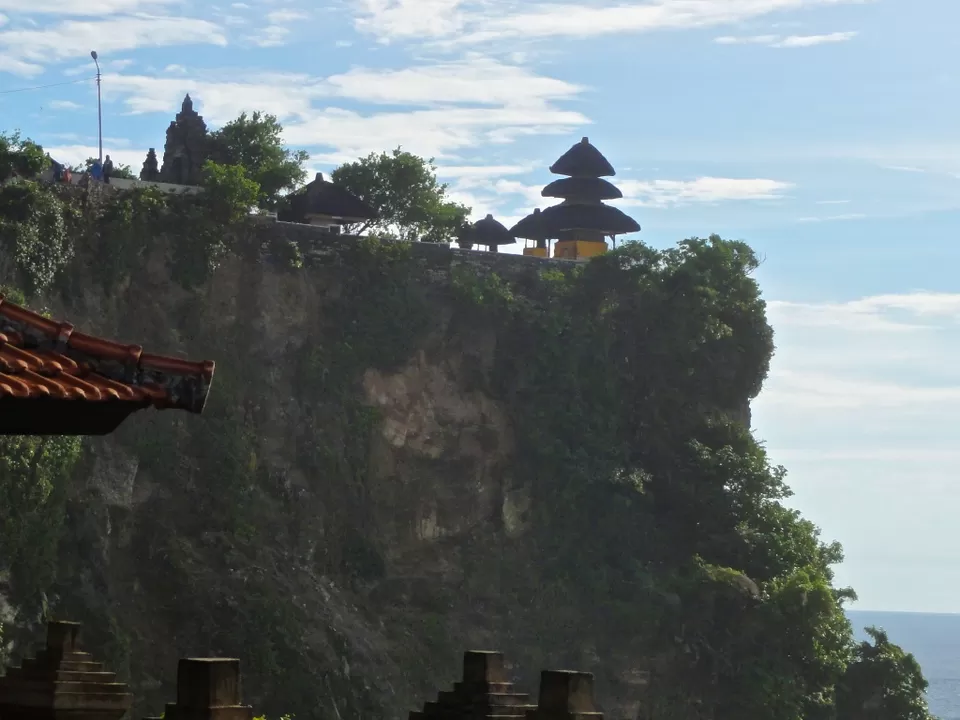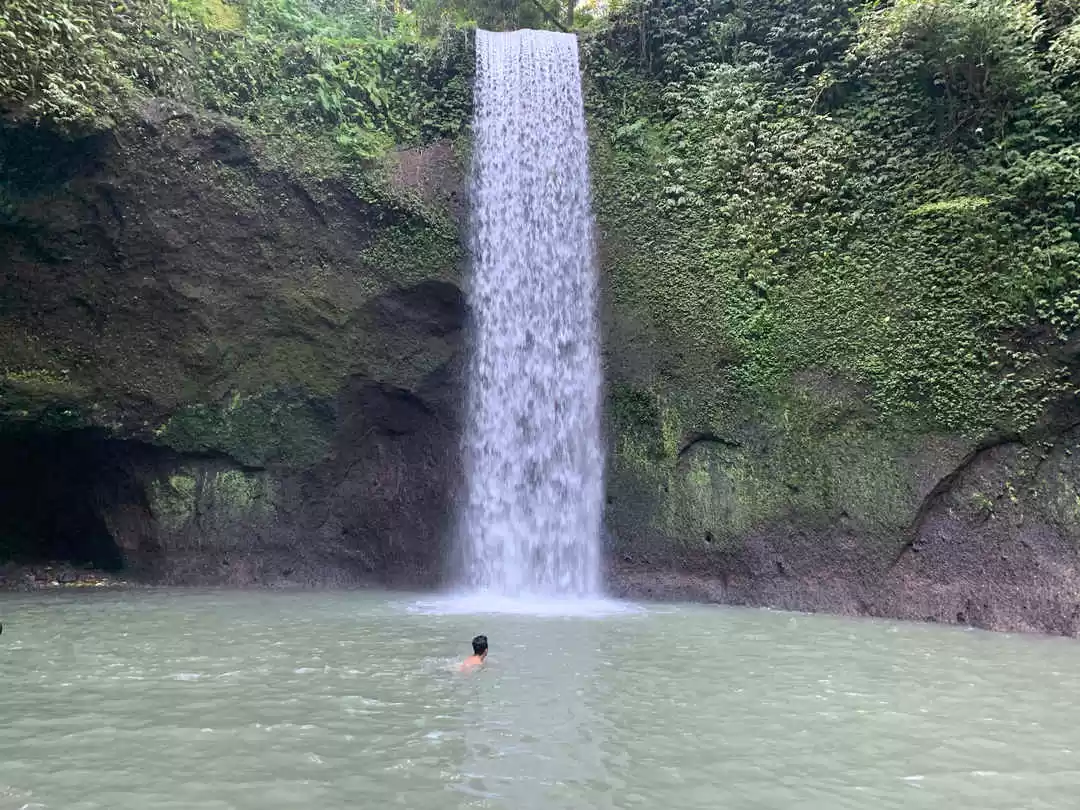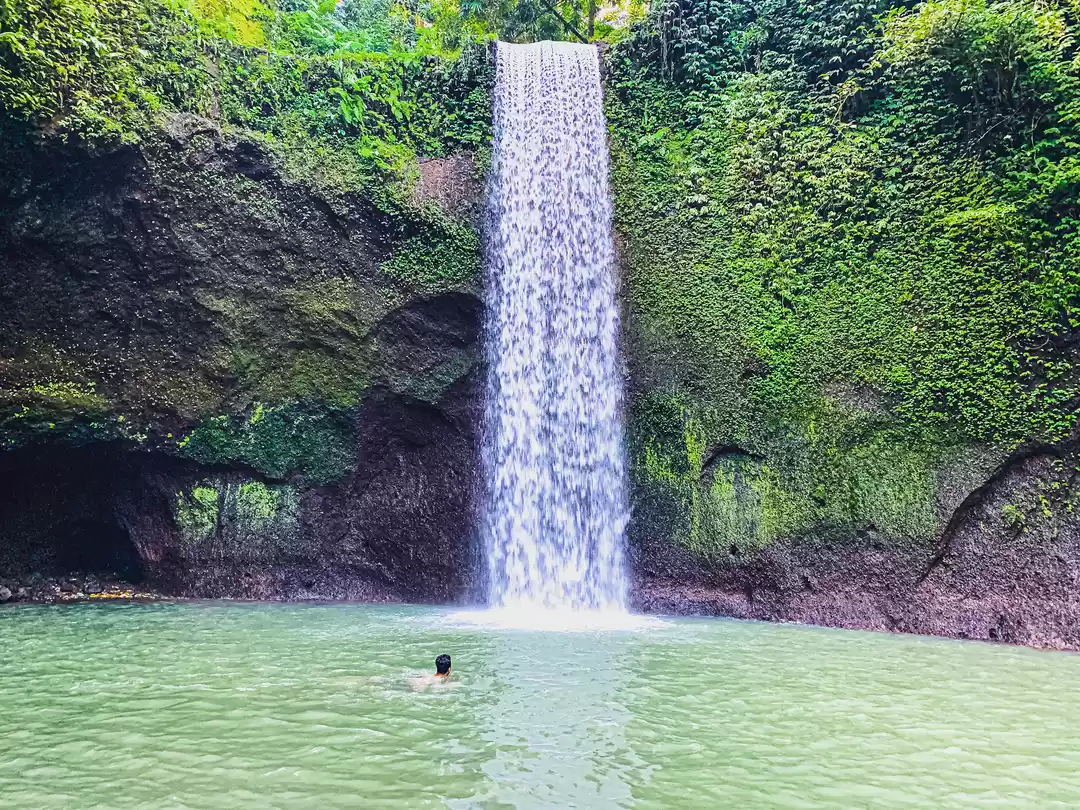










This town is the culture spot of Bali. It is centred around the Ubud market (mainly for tourists), and extends several kilometres in all directions. Ubud is noticeably cooler than Denpasar, being at ~500m altitude. There are museums, art galleries, temples and palaces, expats, and artist retreats, while the town itself has made an effort to preserve a traditional theme. There are also hotels, guesthouses, and homestays, plus an assortment of local and western restaurants, and travel agents. There are tours on offer galore, for Ubud and other parts of the island and on to other destinations. Thankfully, there is as yet no sign of a McDonalds or Starbucks, fingers crossed things stay that way.

The opposite of Ubud is Kuta, on the southern tip of Bali, to the south of Denpasar. Kuta is the image many people have of Bali. It starts with a long beach, with the usual assortment of beach chairs, beach vendors, and all of the relaxing things one can think of. On the three or four streets back is the beach life commercial infrastructure. There are several shopping malls, restaurants, hotels, and cafes. The further back you go, the more ‘traditional’ are the shops. In these shops there is an assortment of items: Bali masks next to t-shirts and ginormous wooden penises juxtaposed against camera batteries and knock off DVDs. Bargaining is a fact of life, never accept the first price offered, but don’t try and be too cheap—these people do need to make a living. Unsurprisingly, there are hookers in Kuta. They hang out on the beach at night, and at the site of the Bali bombing memorial.Should you visit Kuta? I was of two minds, originally I decided not to go, I have seen beach spots before (and, hailing as I do from the great southern continent, the beaches in Kuta are not so great), however, I did spend a day there, and I am glad that I did. There is that drunken element, and an amount of sleaze—the many bars and nightclubs—but a lot less than other places, and, well, if that is what people want, fair enough.

Away from Kuta is Denpasar, the capital city of Bali, and it is a rather sprawling, low rise town, easy to get lost in, but also easy to find your way out of. In itself it is not a tourist destination, being more an assortment of functional streets, but there are a bunch of major sights worth seeing in and around the city. What I liked most about Denpasar is the plethora of small restaurants, many of them vegetarian or at least having a specific and substantial vegetarian menu. Walking around Denpasar is not easy, the footpaths are broken and used by shops to display merchandise. Most locals ride a bike.

This is an impressive looking temple, and if you like temples, this is a must see. Though, as you approach, you will be approached by locals who wish to offer you their services as a tour guide. These people will invariably say that they cannot ask for payment, as they are a Hindu, but that you can make an offering to them, depending on how well you consider their tour guiding to be. Personally, I prefer an upfront price (something you can negotiate with), rather than this pseudo-modesty. Also, these guys in reality, know little about the Temple. So, don’t expect too much. If you do accept their offer, say 20,000 rupiah ($2) is an acceptable sum, though they will tell you that the previous visitors paid them $10 (or $20, or whatever).

This museum is located on the east side of the central square of Denpasar, and is worth a visit, but few people bother to do so. It is medium sized, has good English language signage, and consists of a four main pavilions constructed in the Balinese style of architecture. The main building displays prehistoric and traditional artefacts, the other pavilions display costumes, textiles, and contemporary items. There are often wedding parties in the Museum, with the optimistic groom and happy bride having their photo taken. The Museum staff also, occasionally, organise performances of art, culture, and dance.

In the evening, around sunset, there are fire dancers (people dancing with flaming, wooden sticks), and other entertainment there, but, it is still a temple. You are not allowed, as a tourist, into the inner parts of the main Temple, though you can see most of the inner complex from outside. There are, of course, a line of small restaurants outside the Temple. All in all, fun, but a tad micro-managed, don’t expect to see anything that a million others have not seen.One thing, monkeys! The Temple is home to a lot of monkeys. They are not dangerous, but they will try and steal your stuff. Anything they can grab. If this happens, ask one of the Temple guards in the vicinity to get your stuff back—a 50,000 rupiah tip. If you have had experience with monkeys before, you will know the score.

This four century old Hindu temple is located in Mengwi village, about 18km from Denpasar. The village itself is worth a visit. The temple is separated from the surrounding land by a moat and a series of garden terraces. Entry into the grounds is not allowed to visitor, but the inner buildings can be seen, and photographed. The grounds are beautiful and well maintained, and with lots of tourists.

I spent one day in the village of Blimbing in central Bali. This was a an attempt by myself to experience and learn something of the traditional life of the Balinese people. Essentially, Thai rice farming is on flat land, while Balinese is on hills, thus lots of terraces. This may seem a small difference, but it affects most aspects of rice production.In this village, and in Bali as a whole, people farm almost in the same manner that their ancestors have done for centuries, but not entirely. Walking around in the fields, people have mobile phones and 3G. There is a new, hi-tech, “brand” of rice being trialled in the village, and children now, both receive a primary school education, and have the option of going to the “big city” for work and adventure. Also, in general, people know about the outside world.Blimbing was a pleasant stay. A few details. There are ~6,000 people in the village, which is divided into eight sub-districts (“bun-ya-dynas”), and covers ~11,000 hectacres. The land can manage up to three crops a year, and one hectare produces each year (when things are good) four tonnes of rice. A farm worker, can expect to make ~50,000 rupiah ($5) a day. An average, wooden, house costs forty million rupiah ($4,000), which is 800 days work. This salary is sufficient to live on, and living on a farm supplies many necessities of life. There are three primary schools in the village, but older children must go elsewhere for higher education, which many now do.It was a fascinating experience living with the family. There was quietness to their pace of life, a calmness. Of course, as a paying visitor you are shown the best, and there was a sizeable language gap. As a vegetarian, there were a few dietary misunderstandings, but as Hindus, they appreciated the worth of a vegetarian lifestyle, though it is tricky to achieve living on a farm. If you are interested in this, you can arrange to stay at Blimbing with most travel agencies on the island, or phone di

This is a picturesque and major tourist destination, to the west of Denpasar. This a five century old Hindu temple, which forms part of the good fortune of the island, bringing rain and a fertile crop to farmers. The temple itself is on a tiny island a few metres off the coast, accessible only at low tide. People come to visit the temple at sunset, where it is a great photo op, and to brave the seas and wade out to the island. Unfortunately, the temple is closed occasionally for refurbishment, which was the case during my visit. :(. Getting there is not difficult, if you have your own bike or car, just head north, lots of signs. Otherwise there are tours and buses. The temple also offers fire dances and other diversity.

This is an art gallery, which exhibits paintings of naked and topless Balinese women from a half century ago. Great. It is also a restaurant, cultural centre (Balinese dance), and is based around the work of the late Spanish artist Don Antonia Blanco. This guy arrived in Bali back in the 50s (Franco’s Spain), was given land by the local King, and proceeded to spend his life painting nude Balinese women. Now his home is a gallery. His paintings are certainly worth a visit, he could wield a brush, but no photography allowed.

This is a 15th century set of rock carvings, which can be reached on foot from the town, though it is a few kilometres. From the entrance, a long walk down, on sometimes broken steps, there and back is maybe 4kms. During my visit in January 2014 I was surprised by the absence of vendors, also by the lack of other visitors. This is not on the tourist trail.At the end of your mini-trek you will seen a ~50 metre long line of rock carvings on your left. These depict scenes from every day life, in the good old days. The carvings are worn, but clearly discernable. The principal feature is a statue of the Hindu god Ganesh. If you wish, you can make (after buying from a little old lady nearby) an offering here.Near the entrance is a good, small restaurant, the Yeh Pulu Cafe. Owned and managed by an enterprising Balinese woman. Both Yeh Pulu and the restaurant are recommended.

This is a Hindu temple, and a popular tourist attraction. To get there, buy your ticket, and walk (run?) past the numerous vendors selling the usual range of tourist trinkets. Then descend some steps and you are in the temple area. There are numerous Hindu structures, figures and symbols, all in stone. What you are looking for is the entrance to the cave. This is immediately obvious, due to the large, demonic figure carved in and around the cave entrance. Walk in, take a little care as the floor is slippery, and you will come to a T junction a few metres in. At both ends of the T are lingam and yoni statues, and a statue of Ganesha. Feel free to take a photo, everyone else, including the locals does. You can take a short jungle hike on several paths leading from the temple.

This is a Hindu temple in the centre of Bali. It is famous as its holy water can wash away sins. To participate in this ritual, you first need to buy a ticket, then proceed further into the temple. Keep going, just follow the crowd, and you will come to a series of open air rock pools where you can immerse yourself to whatever degree you feel is required, to wash away your sins. I merely dipped my hand into the water. This temple is popular, with both locals and visitors, it is always busy. Take care when walking on the rock, it is slippery. There is a happy feel to the place. Much laughter and good cheer.

This was the most impressive site I visited in Bali. It is a 11th-century temple complex, a series of rock-cut shrines and images, carved into a cliff face, built for a king and his wives. It is a little far from Ubud town for an easy walk, so public transport, a tour, a bus, a taxi—up to you, as we say in Asia.You start at a long walk down, on stone cut paths, lined with the usual tourist shops. Eventually, you will come to a T junction, turn left, and there are the first set of rock excavations, large openings cut into the rock. This has been referred to as a city, and it does indeed look like a very small city. Return back the way you came, cross over a small bridge, and you will have reached the shrines. These are five small structures, cut into the rock. There is holy water here as well. From here, go back a little, and you will see a small city, with building like structures also cut into the rock.

I originally planned on staying in a hotel in Denpasar, and moving around the island from town to town, to see everything that I wanted to see, however, plans change. I met a Balinese woman in Perth, Erna, who was studying tourism, and she invited me to homestay at her house, and her brother is a driver. This turned out to be a good alternative to another hotel, and her brother drove me around the island for the reasonable sum of $50 a day.
Bali has been a tourist destination for Australians since at least the 1970s, but I myself had long avoided visiting the island, due to its perceived young person/drunken vibe, yet time and circumstances suggested that I spend a few days here. To begin with the conclusion—I greatly enjoyed my time in Bali. I swam on some of the beaches, sat and relaxed under a coconut tree, visited many temples, town, and museums, spoke to people, and generally enjoyed myself. My experience was different from the stereotyped image of dipsomaniac beach bums (not that I have anything against beach bums). There is in fact a great deal to do on the island. I can see why people return time and again. Sadly, I was only able to spend four days on Bali. My visa, due to the nautical nature of my arrival, could not be extended.
A little bit of background. First, Bali is an island (I am sure that you knew that), located a few kilometres to the east of Java, a province of Indonesia, home to maybe five million people, ~150x80kms in size, with a predominantly Hindu population, unlike most of Indonesia, which is predominantly Muslim. The island has a variety of environments. In the south, Kuta, the beach goers destination. A little to the north is Denpasar, the island’s capital city. The central and northern two thirds of the island still follow the traditional life of rice farms and villages, however, amidst these endless, terraced rice fields you will find more hotels, resorts and tourist spots. These cater to the non-Kuta, non-beach going tourist population.
The range of tourist activities in Bali is enormous. With the exception of Disney Worlds, ferris wheels, and casinos there is nothing you cannot find in Bali. The obvious, in the Kuta area, all the water sports you can think of: boat rides, surfing, diving, skiing, are all there, and cheap (by Australian standards).
If you desire history, culture, and art, you will find this in the Ubud (“U-bood”) region of Bali. If you desire to “get away from it all”, then head to the north and centre of the island, where there are rural styled resorts and guesthouses, also village homestays—where you can, more or less, experience traditional life. Here there are rice and paddy fields, exotic, herbs, spices, traditional villages, batik, jewellry, and paintings. It is fascinating how in many ways life for these people has not changed for centuries, though now, thanks to modern communications villagers know of and can participate, with the wider world.
A few Balinese phrases to know (Balinese is a different language from Indonesia):
Hello (the most important) = “Swas-tias-tu” or “Hello”
How are you? Kenken kabare?
Thank you. Matur suksma.
Things to be aware of. December to March, heavy monsoon rain, but this rain occurs usually in the afternoon, for a few hours only, and not every day. Also, the rain is warm, unlike the Australian winter rain. For me, it is not a problem. Wear a hat, or simply get out of the rain for a few hours, but if you are so inclined carry an umbrella. Mosquitos—the greatest problem in Bali, and Asia. Mosquitos carry disease, dengue fever, malaria, and whatever. When you arrive at your accommodation, spray your room with DEET. When you go out, spray your clothes with DEET, roll some rollon DEET onto your exposed skin. I store my clothes in airtight bags, and spray the interior of the bag with DEET. This keeps my clothes soaked in the substance.
There were a few things I did not like about Bali. First, smoking, smoking is far more common than in Australia, and coming from Oz, I noticed the difference. What is most annoying is that smoking goes on in restaurants (except most of the veg restaurants). One more thing, transport. Road travel is slow. There is only one road to most destinations, and it will be a narrow and busy road, filled with traffic. Don’t expect to go anywhere quickly. Estimate 30-40kms per hour.
Frequent searches leading to this page:-
Bali honeymoon package, Top places to visit in Bali for honeymoon, Bali tour package for couple, Bali Indonesia package tour with airfare, Bali Indonesia tour package, Bali tour package from India, Bali honeymoon package cost





































